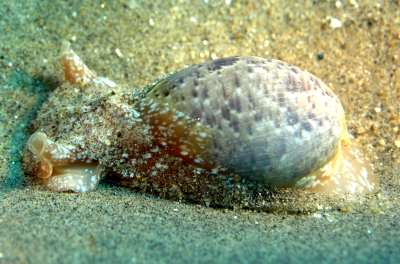
Bulla gouldiana
Pilsbry, 1893
Order: CEPHALASPIDEA
Family: Bullidae
DISTRIBUTION
West coast of North America from Alaska to Baja California and Equador.
PHOTO
Vallecitios Wall, La Jolla Shores, La Jolla, 10m, CA, USA, East Pacific, 20 February 2006. Photographer: Barbara Jeanne Lloyd.
This large cephalaspidean species, like all of the genus, has a heavily calcified external shell. This 'bubble' or 'bubble shell', as they are often called, is similar to members of the genus Haminoea, but in that species the animals are usually smaller, and the shell much more transparent and fragile. Found from Morro Bay, in central California south to Ecuador, this species reaches over 55 mm in length. It was named after the biologist Augustus Addison Gould.
Bulla gouldiana lives in protected waters on a mud or sandy bottom. Species of Bulla are herbivores, feeding on green algae. Bulla gouldiana is most active at night, spending the day buried in the sand or mud. The exposed shell has a distinctive pattern, and the semi-transparent mantle is brown with varying degrees of mottled bluish pigmentation. At the southern most extent of its geographic range it overlaps with a tropical but similar species, Bulla punctuolata A. Adams in Sowerby, 1850.
- Behrens, D.W. & A. Hermosillo. 2005. Eastern Pacific Nudibranchs - A guide to the opisthobranchs from Alaska to Central America. Sea Challengers. 137 pp.
- Camacho-Garcia, Gosliner and Valdes. 2005. Field Guide to the Sea Slugs of the Tropical Eastern Pacific. California Academy of Sciences. 129 pp.
- Farfan, B. C. and Ramirez, L. F. B. (1988) Spawning and ontogeny of Bulla gouldiana (Gastropoda: Opisthobranchia: Cephalaspidea) . The Veliger 31: 114-119.
Behrens, D.W, 2006 (March 2) Bulla gouldiana Pilsbry, 1893. [In] Sea Slug Forum. Australian Museum, Sydney. Available from http://www.seaslugforum.net/find/bullgoul
Related messages
Bulla gouldiana - egg laying
August 9, 2006
From: Kevin Lee
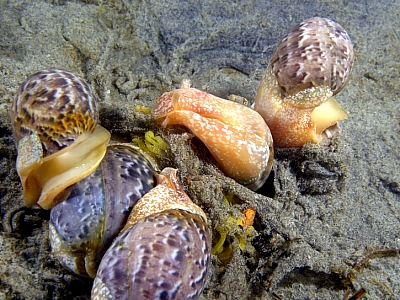
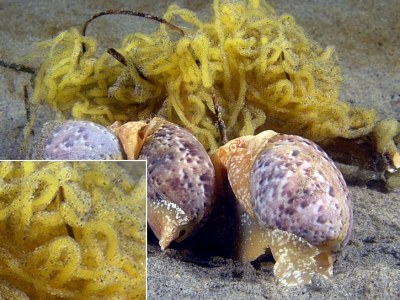
Hi Doc,
Here are more photos of Bulla gouldiana [Gould's Bubble Snails] , still proliferating at La Jolla. Last week the critters were clumped in tight aggregations, perhaps amorous. In nearly all instances, the groups were intertwined in yellow stringy "stuff". Perhaps eggs of this species?
Locality: La Jolla Shores Canyon, Main Wall, 30~35 fsw, California, USA, Eastern Pacific, 27 July 2006, Sandy bottom. Length: 6 cm. Photographer: Kevin Lee.
All best,
K:-)
diverkevin@gmail.com
Kevin Lee, 2006 (Aug 9) Bulla gouldiana - egg laying. [Message in] Sea Slug Forum. Australian Museum, Sydney. Available from http://www.seaslugforum.net/find/17315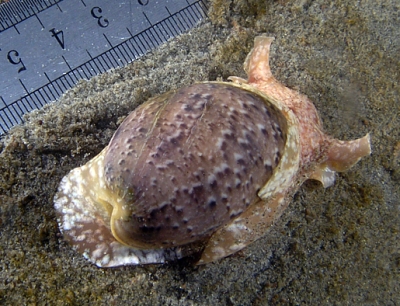
Dear Kevin,
It looks like you have found a group egg-laying. Some time ago - 3 years ago in fact - I posted a message [#9364] describing some research showing that some species of Sea Hare have a pheromone in their egg ribbon which they called attractin because it causes sea hares to aggregate around the egg ribbon. I have just noticed a couple of later papers on the topic which I will post a message about when I get a moment. The interesting point is that perhaps Bulla also has a pheromone in its egg ribbon to attract specimens of Bulla to aggregate around egg strings in the same way.
Best wishes,
Bill Rudman
Bulla gouldiana aggregation, San Diego
May 25, 2006
From: Mike Neubig
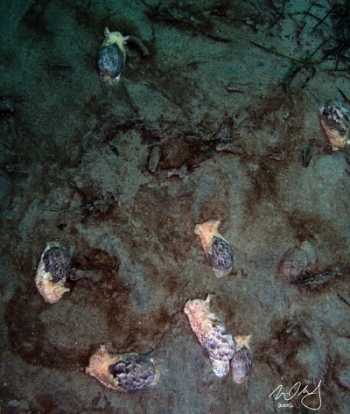
Following on from my last message [#16670] I thought you might enjoy this group photo of eight Bulla gouldiana. Also in the photo is a mucus tube derived from an individual that is off the left edge of the photo. This photo depicts a particularly dense cluster. More generally, in this region of the canyon rim, today, there would be 2 Bulla per field.
Locality: Valley-Sea-Toes, La Jolla Shores, 14m, California, USA, Eastern Pacific Ocean, 20 May 200, sandy sloping shoulder of La Jolla Canyon. Length: 20 mm typ (shell). Photographer: Mike Neubig.
Mike Neubig
mike.neubig@gmail.com
Neubig, Mike, 2006 (May 25) Bulla gouldiana aggregation, San Diego. [Message in] Sea Slug Forum. Australian Museum, Sydney. Available from http://www.seaslugforum.net/find/16673Dear Mike,
It certainly looks like this is a good year from Bulla gouldiana in the San Diego region. In this photo it looks like the Bulla are grazing on a dark brown algal or bacterial layer covering the bottom. The pale grey areas, I presume, are areas they have scraped the layer off. From my experience, species of Bulla tend to feed on green algae or 'algal' layers like this.
Best wishes,
Bill Rudman
Re: Gould's Bubble Snail - aggregation
May 25, 2006
From: Kevin Lee
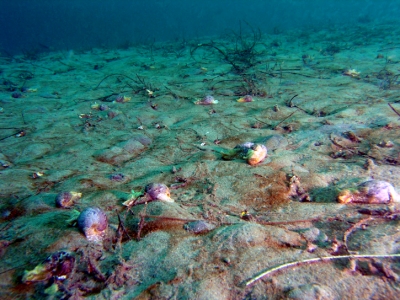
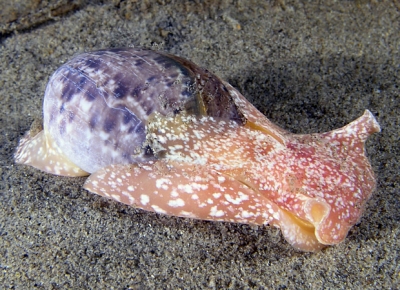
Concerning message #16504:
Hi again, Bill,
Keeping your request in mind (#16504), I revisited La Jolla Shores (California) in search of Gould's Bubbles [Bulla gouldiana ]. On my second attempt, my trusty buddy, Jackie, led us right to a stampeding "herd". In the widest angle shot, there are at least 20 snails, visible. Five critters in a 10 inch frame. Thus, extrapolating, I estimate, in the area, the snails numbered in the thousands. Photos are attached.
Locality: La Jolla Shores, approx 25 feet, San Diego, California, USA, Eastern Pacific, 21 May 2006, sandy bottom, with patches of green algae. Length: average 2 inches. Photographer: Kevin Lee.
PS: The dive day ended on a high note as I attended David Behren's nudibranch presentation at the Birch Aquarium. Very interesting & humorous. He sure knows his nuds!
K:-)
diverkevin@gmail.com
Lee, K., 2006 (May 25) Re: Gould's Bubble Snail - aggregation. [Message in] Sea Slug Forum. Australian Museum, Sydney. Available from http://www.seaslugforum.net/find/16699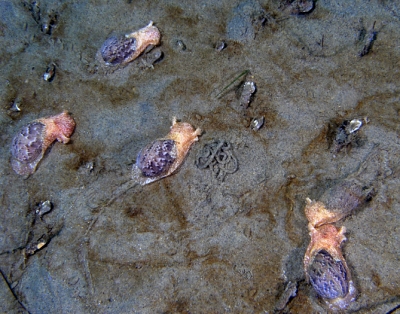
Dear Kevin,
By coincidence I am just posting messages from Mike Neubig [#16673] which illustrate what I guess is part of widespread aggregation in the San Diego area. I see the dark brown layer is covering the bottom in your photos too. Thanks very much for the photos. Species of Bulla certainly seem to be either in boom or bust populations
Best wishes,
Bill Rudman
Bulla gouldiana behaviour from San Diego
May 25, 2006
From: MIke Neubig
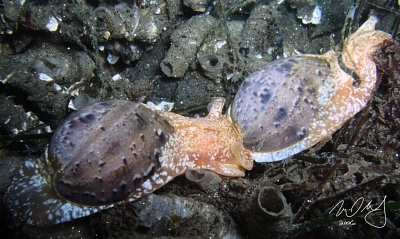
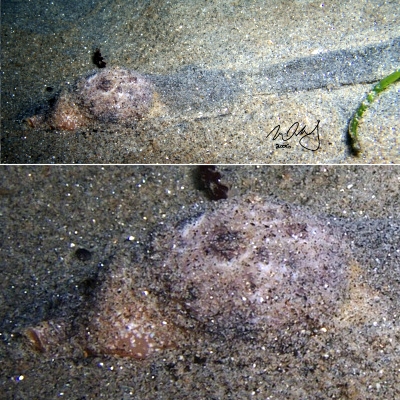
Thought you might enjoy these behavior photos of Bulla gouldiana (Gould's Bubble Snail). The portion above the sand bottom of the mucus tube could have been 2 feet long. During this particular dive, I had seen Bulla here and there, including several feeding (seemingly) on loose blades of Macrocystis pyrifera, a brown alga. Then, when it was time to head back in, I came up over the canyon rim and onto the shoulder only to find dozens and dozens and dozens. These photos are from that congregation. Since red algae is not listed on the Bulla fact sheet as a food, I'll look for some photo ops documenting this this afternoon, as well as some herd shots.
Locality: Valley-Sea-Toes, La Jolla Shores, 14m, California, USA, Eastern Pacific Ocean, 19 May 2006, sandy sloping shoulder of La Jolla Canyon. Length: 25 mm tpy (shell). Photographer: Mike Neubig.
Mike Neubig
mike.neubig@gmail.com
Neubig, M., 2006 (May 25) Bulla gouldiana behaviour from San Diego. [Message in] Sea Slug Forum. Australian Museum, Sydney. Available from http://www.seaslugforum.net/find/16670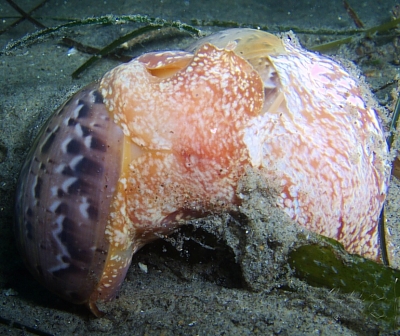
Dear Mike,
Thanks for these shots. The one alongside defintiely shows two animals mating. If you look carefully you can see a pale orange tube [the penis] running diagonally from the lower side of the head of the darker animal into the mantle cavity of the paler animal.
Best wishes,
Bill Rudman
Gould's Bubble Snail - shell damage
May 3, 2006
From: Kevin Lee
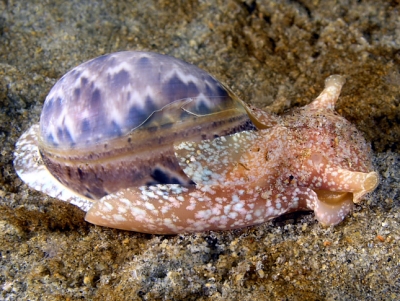
Hi Doc,
On completing a recent dive at La Jolla Shores Canyon, I came across hundreds of snails on the sandy bottom, crawling amongst large patches of green algae. On closer inspection, it seemed the rhinophores resembled those of some nudibranchs. Thus, I snapped some fotos and, shazaam, on arriving home, and consulting Behrens' book (EPN), discovered the critter is indeed an opistobranch, Bulla gouldiana (Gould's Bubble Snail). Mistook it first as Bulla punctuolata.
Locality: La Jolla Shores Canyon, approx 25 feet, California, USA, Eastern Pacific, 06 April 30, sandy bottom, with patches of green algae. Length: approx 1.75 inches. Photographer: Kevin Lee.
Then searching the SeaSlugForum, was happy to learn that a friend, Barbara Lloyd, (whom I've not met yet), already posted some nice fotos [message #16369 ]. I submit another to show the beauty of the shell (might you know if the visible cracks signify a natural process or damage?).
Best regards,
K:-)
diverkevin@gmail.com
Kevin Lee, 2006 (May 3) Gould's Bubble Snail - shell damage. [Message in] Sea Slug Forum. Australian Museum, Sydney. Available from http://www.seaslugforum.net/find/16504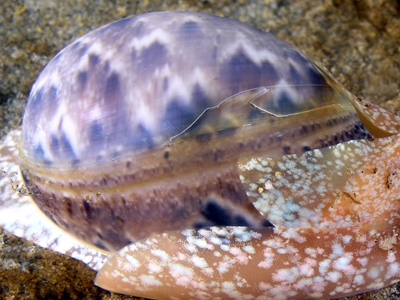
Dear Kevin,
If you have by chance a photo showing a whole 'herd' of Bulla it would be nice to add to the Forum. Species of Bulla seem to one of the opisthobranch groups which either are present in large numbers or not at all.
The shell damage in your photo is 'natural' in the sense of Lord Tennyson's " Nature, red in tooth and claw ..." I suspect a fish or more likely, a crab, has been trying to get at the animal by breaking away the lip of the shell. Fortunately Bulla has still retained a shell big enough and strong enough for the animal to be able to retract inside far enough to escape hungry predators. The reason the new shell, which has grown to replace the old damage, is a different colour pattern, is that the edge of the mantle must have been slightly damaged as well. The mantle is a layer of tissue which lines the inside of the shell wall. The outer edge of this tissue secretes the calcium salts and organic matrix which builds the shell. It also contains the pigment cells which produce the shell colour pattern. In nudibranchs, which have lost the shell, you will often see the dorsal skin of the animal called the mantle. This is because we think this is what became of the old mantle when the shell was lost.
Best wishes,
Bill Rudman
Bulla gouldiana from La Jolla, California
April 17, 2006
From: Barbara Jeanne Lloyd
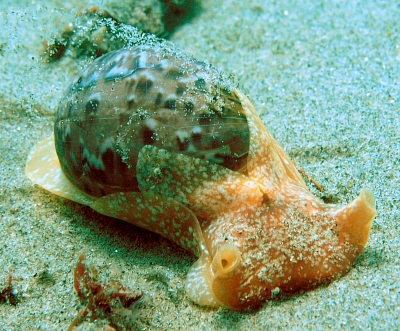
Once again, I came across these in the flat sandy area. And once again, my lights failed me. But alas, my camera did not. This shot is much better than the last, and it shows the detail of the shell. Also, you can see the rolled head tentacle and the foot distinctly.
I find it interesting that in the six years I have dived this site weekly that this is only the first season where I have found these guys, or at least in abundance and size. This year I have found them in three distinct areas of this locality. They certainly only seem to like the flat, sandy areas at LJS.
Another interesting point, is this was a day dive and the water was unusually clear. There were at least a dozen of these guys. I was at the end of my dive and was reaching my gas limit so I can't say how many there really were, but these guys were much bigger than the ones I photographed 6 weeks ago.
You can see more of these snails at:
http://www.divascuba.com/photo_gallery/thumbnails.php?album=4
Locality: Vallecitios Wall, La Jolla Shores, La Jolla, 12m, California, USA, East Pacific , 2 April 2006, Sandy euphotic zone. Length: 15 cm. Photographer: Barbara JeanneLloyd.
Barbara Jeanne Lloyd
barbara.lloyd@gmail.com
Lloyd, B.J., 2006 (Apr 17) Bulla gouldiana from La Jolla, California. [Message in] Sea Slug Forum. Australian Museum, Sydney. Available from http://www.seaslugforum.net/find/16369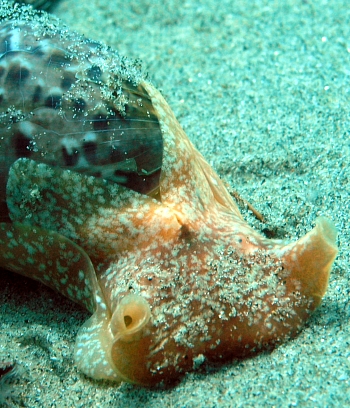
Dear Barbara,
It's nice to get photos of these animals. We tend to think of some of these shelled animals as 'common' and often there are mass 'wash ups' of shells on the beach, but as you have found it is often very difficult to find them alive. I have included a closeup to show how the posterior flaps [or 'ears'] on the head shield, overlap the shell opening and so block sand from entering the mantle cavity within the shell.
Best wishes,
Bill Rudman
Bulla gouldiana - Gould's Bubble Snail
February 27, 2006
From: Barbara Jeanne Lloyd

I received an email from David Behrens mentioning that you were soliciting for shots of Bulla gouldiana. He saw three photos that were posted on http://week.divebums.com for this week.
These photos were taken last weekend using an Olympus C-8080 with an Ikelite Housing and NiteRider dual halogen lights.
Locality: Vallecitios Wall, La Jolla Shores, La Jolla, 10m, CA, USA, East Pacific, 20 February 2006, Sandy euphotic zone. Length: 10 - 15 cm. Photographer: Barbara Jeanne Lloyd.
Barbara Jeanne Lloyd
barbara.lloyd@gmail.com
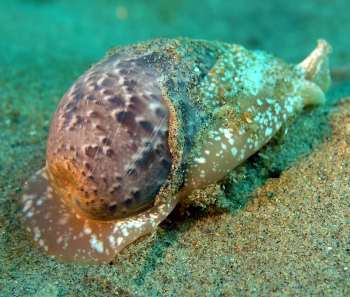
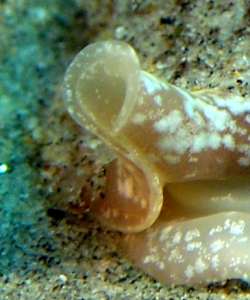
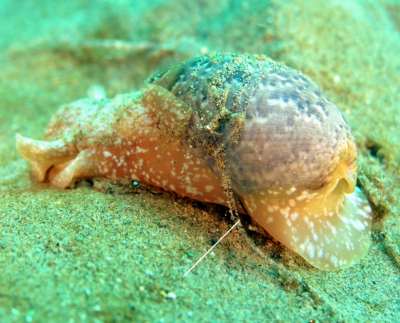
Dear Barbara,
Thanks for these photos. It certainly fills a gap. I've included a closeup showing the rolled left 'rhinophore' or head tentacle which acts as a siphon, drawing water down and over the Hancocks' Organs, which are a sensory patch on each side of the head in cephalaspideans, which sense chemicals in the water.
Also, in the photo alongside I have added a white line to show the distinction between the true foot, which ends about halfway down the shell, and the posterior mantle lobe, which looks like part of the foot, but is in fact an extension of the mantle tissue which lines the inside of the shell.
Best wishes,
Bill Rudman
Bulla gouldiana, detail of shell markings
February 27, 2006
From: Mike Neubig
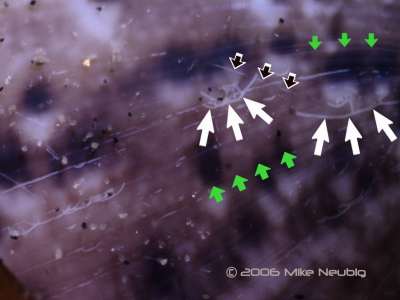
Dear Bill,
Thank you very much for your comments [#10999 ]. A detail of the same individual Bulla gouldiana as in my top two photos show three types of markings. Growth, parasite, predator (green, white, b&w)? It is interesting that the diffuse color patterns are neither delimited or structured by the growth patterns.
Locality: Valley-Sea-Toes, La Jolla Shores,, 14 m, California, USA, Eastern Pacific, 16 February 2006, Gradually sloping sand bottom. Length: 20 mm (shell). Photographer: Mike Neubig.
Best,
Mike
mike.neubig@gmail.com
Neubig, M., 2006 (Feb 27) Bulla gouldiana, detail of shell markings. [Message in] Sea Slug Forum. Australian Museum, Sydney. Available from http://www.seaslugforum.net/find/15911
Dear Mike,
Thanks. The shell colour is deposited by the edge of the mantle - which is a layer of tissue which lines the inside of the shell. The growth lines you see in this species probably represent 'slowdowns' in growth rather than actual stoppages. Sometimes when the shell is edge is broken off, and repair and regrowth occurs, you will see a distinct break in the shell pattern.
Best wishes,
Bill Rudman
Bulla gouldiana from San Diego
February 21, 2006
From: Mike Neubig
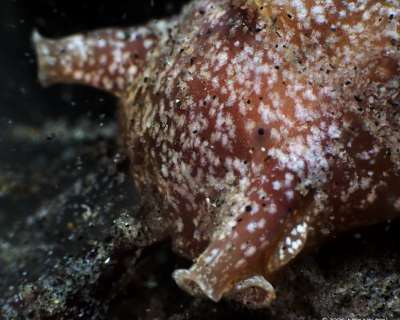
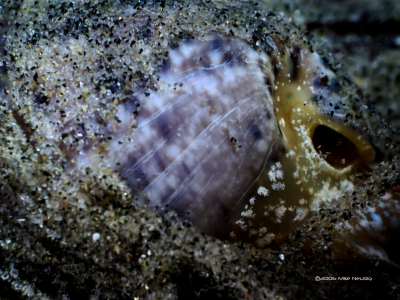
Here are some shots of Bulla gouldiana.
Two individuals, several cm apart, were completely on top of the sand when I came across them on an evening beach dive at La Jolla Shores. The one I settled on to photo (dual HIDs, no strobes, custom lense) seemed to quickly exude and cover itself with a mucous blanket - and proceeded to dive into the sand. The head shot [upper right] with the eye spot was taken before this reaction to the bright light (?) began. The second shot is of the same individual heading under, head to the left. For the next few minutes, a free swimming sarcastic fringehead had my attention. When I looked back, the photo'd Bulla had vanished. The second individual was full below the level surface except for the anterior rhinophores, as in the lower photo.
The speckled patches seem similar to ones in Marli Wakeling's message about Melibe [#10999], in which the possibility of their being microscopic flatworm infestations is put forth. The erratic races on the Bulla 's shell are interesting too, especially how many seem to be half covered.
As the forum search turned up a few posts mentioning this species, but none with photos, I thought I would send these along for addition.
Locality: Valley-Sea-Toes, La Jolla Shores, 14 m, California, USA, Eastern Pacific Ocean, 16 February 2006, Gradually sloping sand bottom, 3 m from the "edge" of La Jolla Canyon. Length: 20 mm (shell). Photographer: Mike Neubig.
Mike Neubig.
mike.neubig@gmail.com
Neubig, M., 2006 (Feb 21) Bulla gouldiana from San Diego. [Message in] Sea Slug Forum. Australian Museum, Sydney. Available from http://www.seaslugforum.net/find/15885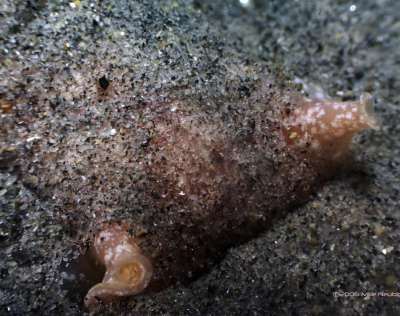
Dear Mike,
Thnaks for these interesting observations. Many of these bubble-shells have lare mucus glands at the front of the head which they use to make a mucus tube to crawl through in fine sand and mud, as you describe. The white speckled patches you mention are small galnds which can exude a white acidic secretion when the animal is disturbed. If look at the other photos of Melibe leonina on the Forum you will see that those in Marli's animal don't appear to be 'normal' for that species, so I suspected an external cause.
Concerning the lines across the shell which break up the pattern, they are growth lines, much like tree rings, which mark periods of growth and no growth on the shell. The uppermost one in your photo actually looks as though the edge of the shell was broken for awhile before regrowth occurred.
If anyone has a photo of Bulla gouldiana I could use for a Fact Sheet, it would be welcome.
Best wishes,
Bill Rudman
